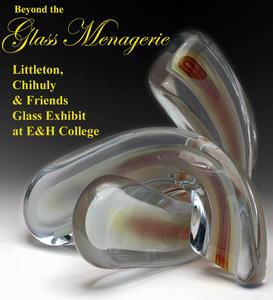

"Alabaster/Yellow Crossed," glass sculpture by Harvey Littleton, is part of an exhibit at Emory & Henry College.
"A glass menagerie that Tennessee Williams could not have imagined" is how Mary Haviland describes an exhibition that will be on view Sept. 26-Nov. 10 in The 1912 Gallery at Emory & Henry College.
The works on view include three-dimensional glass sculptures. Also on display will be flat pieces of art on the wall, brightly colored prints on paper known as vitreographs, not unlike what you find in a printmaking gallery showing etchings or silkscreens or lithographs.
The artworks - whether 3-D or flat - are by the most famous names in the glass-art world, "a luminous assemblage" of vitreographs and glass sculpture produced by Harvey Littleton and artist friends who were invited to his studio.
"Just the name Littleton rings bells with those of us who love glass," says Haviland, Director of The 1912 Gallery. "Moreover, the name also resonates here at Emory & Henry. In fact, Littleton traces some of his paternal relatives back to the early days of our campus."
Haviland adds, "Littleton has made a profound impact on art for two reasons. He is the founder of the contemporary studio glass movement. In other words, he is the father of sculptural glass. And, he is the inventor of vitreography, a process by which multiple prints are created from etched glass plates. This process is far more complex than my simple definition, so we have scheduled an Artalk for those of you who like acid and its chemical reactions."
The artist Dale Chihuly, one of the world's most famous contemporary glass sculptors, has created vitreographs which are distinctly connected to his own glass sculpture. This exhibition includes Chihuly's 3-D translucent Seaform and his Soft Cylinder, as well as his corresponding vitreographic intaglio prints.
In addition to Littleton and Chihuly, the show includes the following artists of international prominence: Warrington Colescott, Erwin Eisch, Herb Jackson, Clarence Morgan, Judith O'Rourke, Italo Scanga, Therman Statom, and Dan Welden. Many are distinguished in painting and printmaking, and they bring these influences into their vitreography.
Both Chihuly and printmaker Warrington Colescott connected with Littleton, their mentor, at the University of Wisconsin at Madison, where Littleton had founded the contemporary glass studio movement in an academic setting in 1963. "Synergy ensued between geniuses and here we have the result," Haviland states.
"Each artist brings a unique approach to working with vitreography. One in particular is a very close friend of Littleton, German artist Erwin Eisch, born in 1927," Haviland continues. "Eisch is most famous for his Kristlnacht Portfolio revealing the horrors of the Nazi era. However, in this show, his vitreograph Keep Going ,Harvey is endearing and full of life. It was chosen for our gallery because it seems to celebrate all of these artists' collective reverence and respect for Littleton."
She concludes, "This exhibition focuses on the artist as inventor, offering experimental concepts and new media in the creative process. It serves as a bridge to critical thinking and experiential learning across the disciplines of art and science. This is the true liberal arts mission. The result is enlightenment."
HARVEY LITTLETON
Father of the Studio Glass Movement
Littleton was not always a glass artist. After earning a master of Fine Arts from Cranbrook Academy of Arts, he embarked on the career of potter and received national recognition for his work as a ceramicist.
In 1959 he began to investigate the possibility of glass as a medium. In 1962 the Toledo Museum of Art invited Littleton to lead a glassblowing workshop, during which Littleton introduced the idea that glass could be mixed and melted, blown and worked in the studio by an artist. Up to that time it was widely believed that glass objects could only be made in the highly structured, mass-produced world of the glass industry where the labor of making glass is divided between designers and skilled craftsmen. One year later, Littleton established a graduate course and glass studio at the University of Wisconsin that attracted as students such well-known artists as Marvin Lipofsky and Dale Chihuly. Museum recognition for Littleton's work in glass soon followed in the form of solo exhibitions.
Littleton retired from teaching in 1976 to devote his time fully to his work. He moved to Spruce Pine, N.C., where he set up his glass studio and produced his most technically demanding and beautiful series of works: the sinuous "Lyrical Movement" and "Implied Movement" groups, "Descending" forms, and exuberant "Crowns" composed of multiple soaring arcs.
Littleton Studios has made its mark in the international art world. The main gallery is now in Florida, between Vero Beach and Fort Pierce, where visitors see rare glass from Tiffany, Steuben, Daum, and Orrefors.
READ ON:
Collectors of Studio Glass Describes Littleton's Work as "Almost Magical"
An Artalk by Master Printmaker Judith O'Rourke on Oct. 16.